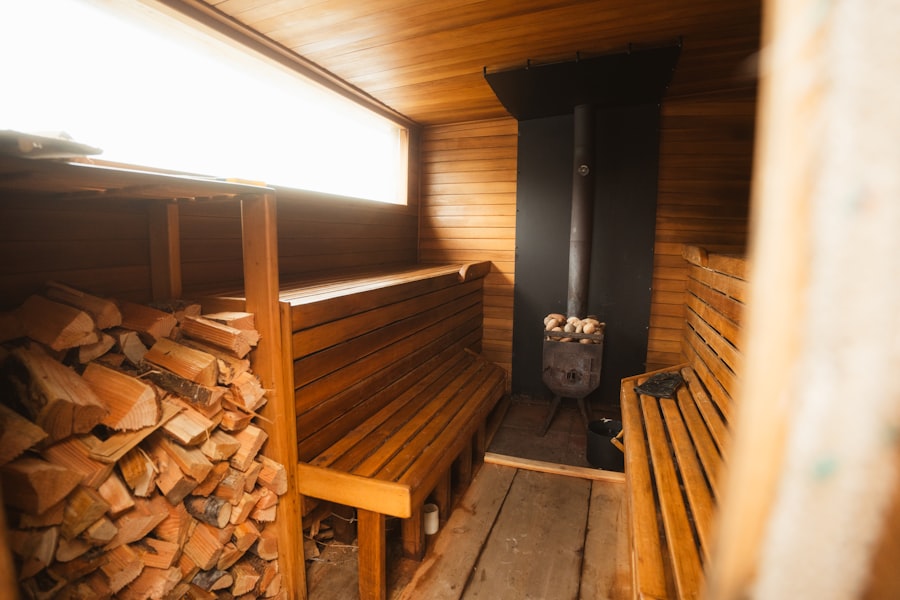In-home saunas have gained immense popularity in recent years, and for good reason.
Individuals no longer need to travel to a spa or gym to enjoy the soothing heat and relaxation that saunas provide.
Instead, they can step into their own personal oasis whenever they desire, making it easier to incorporate regular sauna sessions into their daily routines. This accessibility not only saves time but also encourages more frequent use, leading to greater overall health benefits. Moreover, in-home saunas can significantly enhance one’s quality of life.
The calming effects of heat therapy can help alleviate stress and anxiety, promoting a sense of well-being. Regular sauna use has been linked to improved sleep patterns, as the heat helps relax muscles and calm the mind. Additionally, the privacy of an in-home sauna allows individuals to create a personalized experience, whether that involves listening to music, meditating, or simply enjoying a moment of solitude.
This tailored approach to relaxation can lead to a more fulfilling and rejuvenating experience.
Key Takeaways
- In-home saunas offer numerous health benefits, including stress relief, improved circulation, and detoxification.
- When choosing the right in-home sauna for your space, consider factors such as size, type (traditional or infrared), and materials.
- Proper installation and maintenance of in-home saunas are essential for ensuring safety and longevity.
- Using an in-home sauna can promote relaxation, muscle recovery, and skin health, among other wellness benefits.
- Creating a relaxing spa environment in your basement can enhance the overall sauna experience and promote a sense of tranquility.
Choosing the Right In-Home Sauna for Your Space
Selecting the ideal in-home sauna requires careful consideration of various factors, including available space, budget, and personal preferences. Homeowners must first assess the area where they plan to install the sauna. Whether it’s a dedicated room, a corner of the basement, or even a spacious bathroom, understanding the dimensions and layout is crucial.
This assessment will help determine the size and type of sauna that will fit comfortably within the designated space. In addition to spatial considerations, individuals should also evaluate the different types of saunas available on the market. Traditional steam saunas, infrared saunas, and portable options each offer unique benefits and experiences.
Traditional saunas use heated stones to create steam, providing a classic sauna experience that many people cherish. On the other hand, infrared saunas utilize infrared heaters to emit radiant heat directly into the body, which can be more efficient and comfortable for some users. By weighing these options against their specific needs and preferences, individuals can make an informed decision that enhances their home environment.
Installation and Maintenance of In-Home Saunas

Once the right sauna has been chosen, the next step involves installation. Depending on the type of sauna selected, installation can vary in complexity. Some portable saunas are designed for easy assembly and can be set up in a matter of minutes, while traditional wooden saunas may require professional installation due to their size and electrical requirements.
Homeowners should carefully follow manufacturer guidelines during installation to ensure safety and optimal performance. Maintenance is another critical aspect of owning an in-home sauna. Regular upkeep not only prolongs the life of the sauna but also ensures a hygienic environment for users.
This includes routine cleaning of surfaces, checking for any signs of wear or damage, and ensuring that electrical components are functioning correctly. Additionally, maintaining proper humidity levels is essential for preventing mold growth and ensuring a pleasant experience. By establishing a consistent maintenance routine, homeowners can enjoy their saunas for years to come without encountering significant issues.
Health and Wellness Benefits of Using an In-Home Sauna
The health benefits associated with regular sauna use are well-documented and encompass both physical and mental well-being. One of the most notable advantages is improved cardiovascular health. Studies have shown that regular sauna sessions can lead to lower blood pressure and improved circulation, which can reduce the risk of heart disease.
The heat from the sauna causes blood vessels to dilate, enhancing blood flow and promoting overall cardiovascular function. In addition to cardiovascular benefits, saunas are known for their detoxifying properties.
This process helps rid the body of harmful substances while also promoting healthy skin by opening pores and improving complexion. Furthermore, many users report relief from muscle soreness and joint pain after sauna sessions, making it an excellent option for athletes or those with chronic pain conditions.
Creating a Relaxing Spa Environment in Your Basement
Transforming a basement into a serene spa-like environment can enhance the overall sauna experience. The ambiance plays a crucial role in relaxation; therefore, homeowners should consider incorporating elements that promote tranquility. Soft lighting is essential; dimmable lights or strategically placed candles can create a soothing atmosphere that encourages unwinding after a long day.
In addition to lighting, sound can significantly impact relaxation levels. Installing a sound system or using Bluetooth speakers allows individuals to listen to calming music or nature sounds while enjoying their sauna sessions. Aromatherapy is another effective way to enhance the spa experience; adding essential oils or scented candles can create an inviting aroma that promotes relaxation and stress relief.
By thoughtfully designing this space, homeowners can create an inviting retreat that encourages regular use of their in-home sauna.
In-Home Sauna Safety Tips

Hydration is Key
When using an in-home sauna, it’s crucial to prioritize hydration before and after each session. The intense heat can cause significant fluid loss through sweating, making it essential to drink plenty of water to prevent dehydration.
Time Management and Health Considerations
To ensure a safe and enjoyable sauna experience, users should limit their time in the sauna to 15-20 minutes per session, as recommended by experts. Additionally, individuals with certain medical conditions, such as cardiovascular issues or respiratory problems, should consult with a healthcare professional before incorporating sauna use into their routine.
Avoiding Risky Behavior
It’s also important to avoid consuming alcohol before or during sauna sessions, as it can impair judgment and increase the risk of dehydration or overheating. By following these simple guidelines, users can minimize potential risks and enjoy their in-home saunas with confidence.
Incorporating In-Home Saunas into Your Wellness Routine
Integrating an in-home sauna into a wellness routine can yield significant benefits for both physical and mental health. To maximize these advantages, individuals should establish a consistent schedule for sauna use. Whether it’s a few times a week or daily sessions, creating a routine helps reinforce the habit and ensures that users reap the full benefits of regular heat therapy.
In addition to regular use, combining sauna sessions with other wellness practices can enhance overall well-being. For instance, individuals may choose to meditate or practice deep breathing exercises while in the sauna to promote relaxation further. Stretching before or after a session can also improve flexibility and relieve muscle tension.
By viewing sauna use as part of a holistic wellness approach rather than an isolated activity, individuals can create a more comprehensive strategy for improving their health.
The Future of In-Home Saunas: Trends and Innovations
As technology continues to advance, the future of in-home saunas looks promising with emerging trends and innovations that enhance user experience. One notable trend is the integration of smart technology into sauna systems. Homeowners can now control temperature settings, lighting, and even sound systems through smartphone apps or voice-activated devices, allowing for a more personalized experience tailored to individual preferences.
Additionally, there is a growing emphasis on eco-friendly materials and energy-efficient designs in sauna manufacturing. Many companies are now producing saunas made from sustainable wood sources and utilizing energy-efficient heating systems that reduce environmental impact while maintaining optimal performance. As consumers become increasingly conscious of sustainability issues, these innovations are likely to shape the future landscape of in-home saunas.
In conclusion, in-home saunas offer numerous benefits that extend beyond mere relaxation; they contribute significantly to overall health and wellness. By carefully selecting the right sauna for their space, ensuring proper installation and maintenance, and incorporating safety measures into their routines, individuals can enjoy all that these personal retreats have to offer. As trends continue to evolve within this industry, homeowners can look forward to even more innovative solutions that enhance their sauna experience for years to come.
FAQs
What is an in-home sauna?
An in-home sauna is a small room or enclosed space designed for heat sessions, typically using dry heat or steam. It is installed in a residential property, such as a basement or bathroom, to provide the benefits of a sauna without having to visit a spa or gym.
What are the benefits of using an in-home sauna?
Using an in-home sauna can provide various health benefits, including relaxation, stress relief, improved circulation, detoxification, and potential relief from muscle and joint pain. It can also promote better sleep and skin health.
How does an in-home sauna work?
In-home saunas typically use either dry heat from heated rocks or infrared heat to raise the temperature inside the enclosed space. Some may also have the option for steam, which creates a humid heat environment. Users can control the temperature and duration of their sauna sessions.
What are the different types of in-home saunas?
There are several types of in-home saunas, including traditional saunas with heated rocks, infrared saunas that use infrared light to heat the body directly, and steam saunas that produce moist heat. In-home saunas can also be portable or built-in, and they come in various sizes and designs.
Are there any safety considerations for in-home saunas?
It’s important to follow safety guidelines when using an in-home sauna, such as staying hydrated, limiting the duration of sessions, and avoiding alcohol consumption before or during sauna use. Individuals with certain health conditions, such as heart disease or low blood pressure, should consult a doctor before using a sauna.






